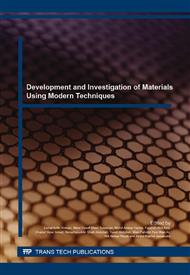[1]
S. Mann, Systems of creation: the emergence of life from nonliving matter, Acc. Chem. Res. 45(12) (2012) 2131-2141.
DOI: 10.1021/ar200281t
Google Scholar
[2]
P.C. Hiemenz, T.P. Lodge, Polymer Chemistry, 2nd ed, CRC Press, Bosa Raton, FL, (2007).
Google Scholar
[3]
P.E. de Gennes, P. Pincus, R.M. Velaso, F. Brochard, J. Physique 37 (1976) 1461.
Google Scholar
[4]
T. Odijk, A.C. Houwart, J. Polym. Sci. Polym. Phys. 16 (1978) 627.
Google Scholar
[5]
G. S. Manning, The molecular theory of polyelectrolyte solutions with applications to the electrostatic properties of polynucleotides, Quarterly Review of Biophysics 11(2) (1978) 179-246.
DOI: 10.1017/s0033583500002031
Google Scholar
[6]
A. Vaccaro, J. Hierrezuelo, M. Skarba, P. Galletto, J. Kleimann, M. Borkovec, Structure of an adsorbed polyelectrolyte monolayer on oppositely charged colloidal particles. Langmuir, 25(9) (2009) 4864-4867.
DOI: 10.1021/la9007608
Google Scholar
[7]
H. Dautzenberg, W. Jaeger, J. Kötz, B. Philipp, C. Seidel, D. Stscherbina, Polyelectrolytes: formation, characterization, application, Carl Hanser Verlag, München, (1994).
DOI: 10.1002/pi.1995.210380118
Google Scholar
[8]
C. Wandrey, J. Hernández-Barajas, D. Hunkeler, Adv. Polym. Sci. 145 (1999) 123.
Google Scholar
[9]
Y. Li, P.L. Dubin, H.A. Havel, S.L. Edwards, H. Dautzenberg, Complex formation between polyelectrolyte and oppositely charged mixed micelles: soluble complexes vs coacervation, Langmuir 11(7) (1995) 2486-2492.
DOI: 10.1021/la00007a029
Google Scholar
[10]
Y. Wang, K. Kimura, Q. Huang, P.L. Dubin, Polyelectrolyte-micelle coacervation: effects of micelle surface charge density, polymer molecular weight, and polymer/surfactant ratio, Macromol. 33(9) (2000) 3324-3331.
DOI: 10.1021/ma991886y
Google Scholar
[11]
P.L. Dubin, Y. Li, W. Jaeger, Mesophase separation in polyelectrolyte-mixed micelle coacervates, Langmuir 24(9) (2008) 4544-4549.
DOI: 10.1021/la702405d
Google Scholar
[12]
D.S. Williams, S. Koga, Cik Rohaida Che Hak, A. Majrekar, A. J. Patil, A.W. Perriman, S. Mann, Soft Matter. 8 (2012) 6004.
DOI: 10.1039/c2sm25184a
Google Scholar
[13]
S. Mukherjee, A. Dan, S.C. Bhattacharya, A.K. Panda and A.P. Moulik, Langmuir, 27 (2011) 5222.
Google Scholar
[14]
K.W. Mattison, I.J. Brittain, P.L. Dubin, Protein-polyelectrolyte phase boundaries, Biotechnol. Progr. 11(6) (1995) 632-637.
DOI: 10.1021/bp00036a005
Google Scholar
[15]
Cik Rohaida Che Hak, PhD Thesis, University of Bristol, (2012).
Google Scholar
[16]
P. Walde, K. Morigaki, Formation and Transformation of Fatty acid/Soap Vesicles in: Self Assembly, B.H. Robinson ed., IOS Press, Amsterdam, 2003, p.443.
Google Scholar


